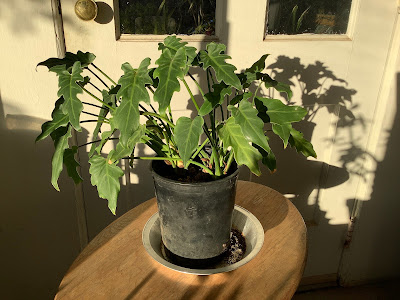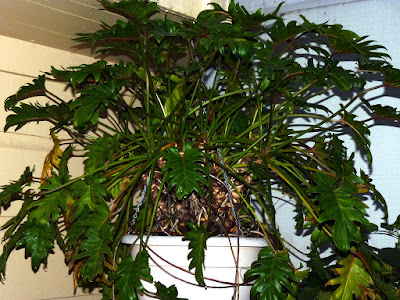Philodendron xanadu is an impressive tropical foliage plant with a compact, tidy growth habit and large, deeply lobed, shiny dark green, tough leaves.
Philodendron xanadu and its scientific name Thaumatophyllum xanadu, is a species of the genus Thaumatophyllum. This species was described by Sakur., Calazans & Mayo in 2018. It is an impressive tropical foliage plant with a compact, tidy growth habit and large, deeply lobed, shiny dark green, tough leaves.
IDENTIFY PHILODENDRON XANADU PLANT
Philodendron xanadu is native to Brazil, but is widely cultivated as a landscape plant in tropical, subtropical and warm temperate climates. The plant was introduced into the American market by an Australian nurseryman in the spring of 1987.
Thaumatophyllum xanadu is a moderately large-leaved perennial, shrub which growing up to 1.6 m tall with the stems of 1 m or more tall. It has deeply divided, usually drooping, dark grey-green leaves that grow up to 18 inches long and 8 to 12 inches wide, appearing on long, smooth petioles leaves, which are beautifully serrated at the edges, and almost seem to attract the light. Each leaf is divided into 15 to 20 lobes. Its flowers have dark red spathes.
When given enough room to spread, this plant makes a handsome foundation or specimen planting, and can also be used in large containers, where it looks especially attractive at poolside. It has similarities in texture and form to Philodendron selloum without its large size. Space 4 or 6 feet apart in a landscape to form a mass planting of coarse textured foliage. Since leaves remain close to the ground, it makes a nice, tall ground cover for any shaded, damp location.
PHILODENDRON XANADU PLANT CARE AND CULTURE
Cultural information should only be used as a guide, and should be to be adapted to suit you. Your physical location; where you grow your plants, how much time you have to devote to their care, and many other factors, will need to be taken into account. Only then can you decide on the cultural methods that best suit you and your plants.
Light:
Philodendron xanadu is an easy-care houseplant, which in summer can be put out on a balcony or terrace. It thrives in every type of light apart from bright, direct sunlight but grows best in bright and indirect sunlight. Exposure to the sunlight can causes a yellowish color in the leaves or a sunburn spot.
Temperature:
Thaumatophyllum xanadu grows well in normal to warm indoor temperatures 24-27ºC (75-80ºF). They cannot tolerate temperatures which drop below about 13ºC (55ºF).
Substrate and growing media:
Philodendron xanadu is very hardy but grows best in loose, well-drained soil which is rich high in organic matter. It also be grow in 100% sphagnum peat moss and mixtures such as peat-vermiculite or peat-perlite. It has a spreading, upright growing habit, it shouldn’t need staking or any support - unlike its vine cousins, but would appreciate a big enough space to really spread out.
The plants benefit from repotting to a larger container when they become root bound and outgrow the original pot. A combination of half soil-based potting mixture and half leaf mould or coarse peat moss is used.
Move the plant into container one size larger only when their roots have completely filed the current one. This is done at any time of year except during the short rest period. After the long rest period the convenient pot size has been reach (probably about 25-30cm (10-12 inch)), an annual spring top-dressing with fresh potting mixture will help to keep the plat healthy. A container with drainage holes to prevent root rot is used. A cachepot is used if a decorative container is without drainage. It is necessary to cover the bottom of a cachepot with pebbles so as to keep the plant above the drainage water.
Watering:
The vital factors in keeping the plant growing evenly with large, uniform leaves is plentiful of water. Keep the potting mix consistently moist, but not wet. Make sure all excess water drains, since sitting in water or overwatering can cause root injury, which will cause leaves to turn yellow and drop. A high-humidity environment should be maintained with a pebble tray or by grouping plants will encourage larger leaves.
Fertilizer:
Thaumatophyllum xanadu are considered heavy feeders. Regular feeding program with a nitrogen fertilizer will increase leaf size and produces a larger, healthier plant. Throughout the months while the plant is actively growing apply standard liquid fertiliser once a month. It's a nice strategy to fertilize more frequently at half strength than to apply one strong dose. Plants which mainly grows in low-light conditions require less fertilization than actively-growing plants. Moist soil requires fertilizers to avoid injury to plant roots.
Pruning:
Use a sharp pruners or scissors to control the size and shape of the plant. You can remove entire leaves by cutting them off at the base of the leaf stem. You can also remove the lower leaves if you want to reveal the plant's stem. Always wear gloves when pruning and wash your hands and tools when finished. You don't want to get the sap in your eyes or mouth.
Propagation:
Cutting and layering are popular methods of Philodendron species propagation. Try propagating them during the growing season. A small brown nubs are formed where the leaves meet the stem. These nubs, when in contact with soil or water, will grow roots. There are many ways to propagate this plant, the easiest being to cut a branch just below a root-nub and place it in water with a few pieces of horticultural charcoal to reduce the likelihood of rot. As soon the growth of new leaf takes place it is potted in the rich soil. Similarly it can also be propagated within its own pot by pinning vines at the root-nub to the soil with hairpins or bent wire. The root nub in contact with the soil will sprout new roots in a very short time. When the different parts of Philodendron species are rooted, the plant will greatly profited from misting several times a day.
BUY PHILODENDRON XANADU PLANT AND RELATED PRODUCTS
BUY ANOTHERS SPECIES AND VARIETIES OF PHILODENDRON GENUS HERE!


















COMMENTS